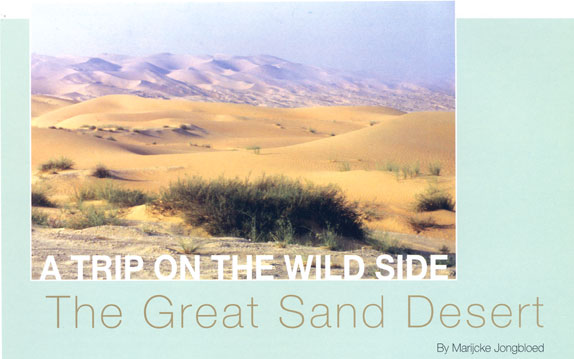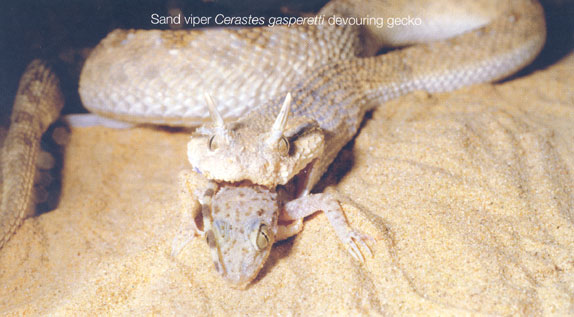|

Ever since as a child I saw a picture of a great sand dune I have wanted
to see one for real. It was one of the reasons I came to Arabia. Those sharp
undulating ridges and soft curves of fine sand were an irresistible combination
for me.
One day a friend, who worked for a wildlife research
station, told me that he had observed sand foxes (Vulpes rueppelli) at close
quarters during a camping trip. I begged him to take me to the spot where this
had happened, so one weekend we set off with two 4WD-vehicles, full of camping
and survival gear. We drove south from Al Ain to the last town at the edge of
the Rub’ al-Khali. There we took a track that led us across huge dunes.
These sickle-shaped barchan dunes are created by the wind and
lie perpendicular to the prevailing wind direction. The windward side on the
south-west is very steep and it is practically impossible to ascend by vehicle
on that side. Camels can do it but even they prefer to find easier routes. So we
were approaching this forbidding terrain from the south-east.
Once we climbed the first dune on its more gently sloping
leeward side, we were committed. Now we had to continue traversing the waves of
this sand sea or be doomed to walking! At the top, our trained desert-driver
stopped to survey the route. The ridge looked sharp like a knife and the sand
was deep and loose.
The landscape in front of us was awesome. As far as the eye
could see the dunes rolled on. Nearby the patterns in the sand were clearly
visible, the wind having sculpted graceful wavelets and sinuous mini-ridges.
Only the valleys between the dunes showed some vegetation.
Coming down the steep side of the dune was excitingly
frightening. The nose of the Landrover was pointing straight down as we plunged
into the abyss, feeling sure the car would go “hood over wheels” the next
second. Then the land levelled out and we were driving on the hard surface of
packed sand of the interdune salt flat.
Our trip continued for hours up and down the dunes, with some
stretches on level ground. The lead car had a GPS system, so we knew at all
times exactly where we were heading. It was late afternoon when my friend
Patrick announced that we had reached the spot where he had seen the foxes. It
was in the middle of a rather wide salt flat with sparse saltbush vegetation.

We lowered our weary bones from the vehicles and walked
around looking for tracks or other signs, but the afternoon wind had swept the
desert floor clear.
We decided to pitch camp and start preparing the evening meal. It was February
and the days were short. As soon as the sun had set it turned very cold. While
it was still light we had gathered wood and dried camel dung for a fire. The
wood came from a few huge arta bushes and a lone ghaf tree that had managed to
grow quite large, even in the harsh conditions that prevailed here.
Patrick and I left the roaring fire for a short foray with
the car away from the disturbance of the camp. A powerful searchlight on top of
the car picked out a hare (Lepus capensis). I had never seen a relaxed hare
before. Usually you only see their backsides as they sprint off. This one sat,
seemingly oblivious of the light that hid our presence, and munched the
bead-like leaves of a Zygophyllum saltbush. Then it leisurely walked over to the
next bush. To my surprise it did not hop.
Small sand geckoes moved like lightning across the flat sand
and disappeared in clumps of sedges. Patrick saw an owl winging its way across
the dunes, but my night blindness prevented me from seeing anything outside the
circle of our search light.
There was no sign of the sand foxes.

Patrick and one of his colleagues set some sand traps to
catch whatever creature might fall into them. We went to bed early, enveloped in
down sleeping bags. I had a small pup tent and slept with my head almost
outside, so I could see the glittering expanse of the starry skies above.
The Milky Way looked like a bridal veil, near enough to be
touched. I located the Big Dipper and by extending the short side of the figure
five times I found the brilliant North Star exactly where it ought to be. On
that comforting observation I fell asleep.
When I woke up the sky was becoming lighter in the East. As the darkness
receded, pearly pink and soft gold colours painted the sky and the heavy mist
that lay over the soft dunes. As the light grew stronger, the mist became
transparent, like the gossamer flowing robes of a dancer. This world had no
limits and no sounds, light and colour filled it to overflowing.
As the golden disk of the sun rose over the horizon, the mist
rose too and revealed the treasure it had carried: diamond dew drops quivered on
every bush and blade, drops of life-giving liquid, precious in this arid land.
A Desert skunk beetle stood on the sand, with its head low to
the ground and its back sticking up. Dew had gathered on its shiny black
carapace and was rolling down its body to its mouth, providing the moisture it
needed to survive another day.
A spider’s web hung like a diamond necklace between two tussocks of desert
grass, luring insects into its embrace with the promise of water.
All around my tent, tiny foxy paw prints could be seen, right
up to the place where my face had been. The sand foxes had visited, but I had
not even noticed!
I recalled that another friend had told me how he woke up
during a camping night to find a fox standing on his chest, checking out his
face with his sensitive little nose! Obviously the foxes here were also not very
shy and who knows, one could have been nose-to-nose with me! I was disappointed
that I had slept so well.
There were other prints also, leaving a record in the sand of the night’s
activity. The tracks of the hare we had seen the night before were very similar
to those of a sand cat that had passed by. Both animals have thick hair between
the pads of their feet. This gives them better insulation against the hot sand
and prevents their feet from sinking in soft spots.
A series of parallel stripes was left by the side-winding
movement of the sand viper. In one spot there even was the perfect print of the
whole snake, where it had lain, coiled up below the sand waiting for prey to
pass.
A series of double oval imprints in the sand had me puzzled
for a while until I remembered that the jird (Jaculus jaculus) hops around on
its hind legs, earning it the nickname ‘kangaroo mouse’.
The sand traps yielded a range of small creatures: beetles,
spiders and two species of geckoes. One of the geckoes (Stenodactylus doriae)
was adorable - I though - with a large head and enormous golden eyes. Its body
was cream-yellow mottled with brown. It posed willingly for my photographs.
Another species (Stenodacytuls arabicus) was only half a finger long and so thin
that it was transparent – you could see its stomach and guts through the skin.
They were both already known from this area, so we did not add anything to the
scientific databank. Still, Patrick recorded everything in his notebooks. Even
the absence of animals in an area is knowledge.
After we had taken all the pictures we needed, we had to
carry on with our trip if we wanted to get to the inhabited world again that
evening. The sun started to burn, even this early in the season.
The light shimmered on the silvery salt of the sabkha between
the dunes, where a few camels were browsing the salt bushes, their hind legs
stained with their liquid stool. The prevalent salt bushes all were the ones
that the bedu call harm. The word “haram” can mean either unclean, forbidden, or
“to be pitied”. The salt water contained in the beady leaves causes diarrhea, so
all three meanings of “haram” apply when a camel eats harm.
From a distance the camels’ legs seemed ten feet tall,
quivering stilts, standing in blue patches of water. But this was a mirage.
There was no surface water in this desert.
Here and there yellow-flowered shrubs made cheerful patches
of colour in the overall beige landscape. This hardy plant was Tribulus omanense,
a favourite food plant of the Arabian oryx that used to live on these plains.
In recent years groups of Sand gazelles (rheem) and Arabian
oryx have been released in the area through which we traveled. It would have
been great to see a herd of oryx walking slowly across the plain against the
backdrop of the immense dunes. This was still in the future at the time when we
made this trip.
We were now driving for long periods of time along the flat
sand between rows of dunes, heading north towards the coast. Suddenly the lead
car stopped.
Patrick pointed towards a small hill that had a
crescent-shaped burrow.
‘I saw Little Owl ducking into that burrow. Let’s see if there are any owl
pellets. They might contain the bones of whatever small reptiles occur here.’
Just as we started to walk towards the hill, we saw a
movement over to our left. A tiny furry animal sprinted from one burrow to
another.
‘What was that?’ I asked, surprised, as another appeared
running as fast as its little legs could carry it.
‘They are sand fox cubs’, exclaimed Patrick, as delighted as
I was. ‘Let’s go over and see if we can get closer.’
We crept as quietly as we could towards the burrow, taking
advantage of small bushes and stands of sedge as cover. At about four meters
from the burrow we dug in and waited. Before long the anxious face of the vixen
appeared in the opening of the burrow. She did not see or smell us and was
obviously reassured when she retreated.
First one and then the other of the cubs crept outside. They
stayed in the entrance and began to doze in the sunshine. Patrick and I started
to take pictures, very carefully. Every time a shutter clicked, the cubs would
jump a little, with unfocussed eyes, and then they’d fall asleep again. Their
baby fur sparsely covered their little round heads and bellies.
It was a well-earned reward for our arduous journey.
Towards sunset we reached the tarmac road again that took us north to the coast.
A trip like this is not something to undertake lightly. The drivers must know
how to deal with the terrain and extra fuel and water must be taken as well as
first aid kits that include treatments for stings and sunburn. The desert
animals do not really pose a danger to people (though one should avoid stepping
on a viper!) but the sun is relentless and dangerous. Getting lost is not an
option so it is best to be guided by GPS at all times.
|